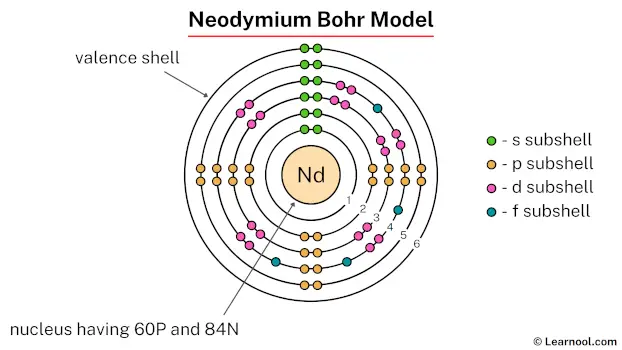
In the neodymium Bohr model, a nucleus with 60 protons and 84 neutrons is at the core. Orbiting this nucleus are six electron shells, housing a total of 60 electrons.
To draw the neodymium Bohr model, outline the 60 protons, 84 neutrons, and 60 electrons. Start by illustrating the nucleus, and then draw the six electron shells. The first five shells should contain 2, 8, 18, 22, and 8 electrons, respectively, while the sixth shell holds the remaining 2 electrons.
Steps
Find protons, neutrons, and electrons of neodymium atom
Neodymium has 60 protons, 84 neutrons, and 60 electrons.
Neodymium protons
- Protons = atomic number
From the periodic table, find the atomic number of neodymium.
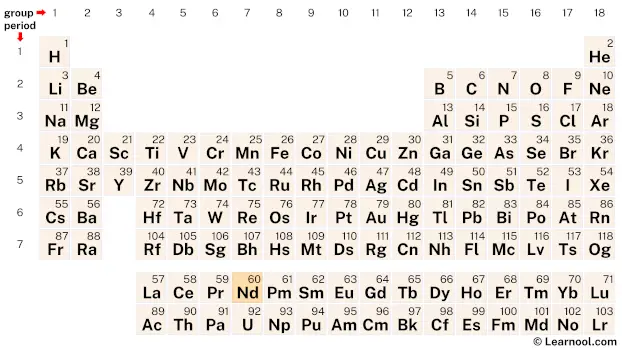
The atomic number of neodymium is 60. Hence, neodymium has a total of 60 protons.
Neodymium neutrons
- Neutrons = atomic mass – atomic number
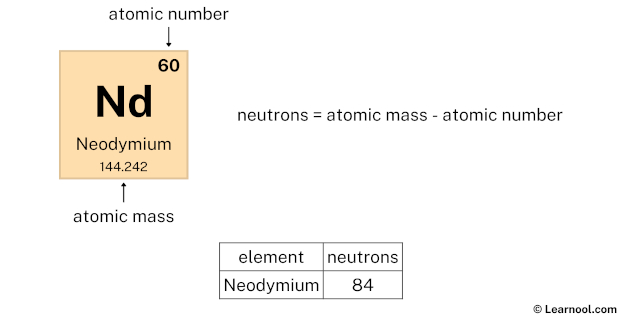
The atomic mass of neodymium is 144.242, so we’ll take the roundup value as 144. And the atomic number of neodymium is 60.
Subtract the atomic number (60) from the atomic mass (144). Hence, neodymium has a total of 144 – 60 = 84 neutrons.
Neodymium electrons
- Electrons = atomic number
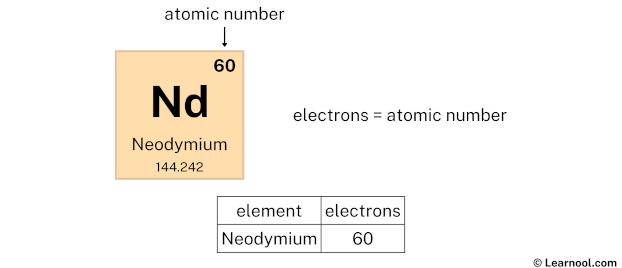
The atomic number of neodymium is 60. Hence, neodymium has a total of 60 electrons.
Draw nucleus of neodymium atom
The nucleus of a neodymium atom contains 60 protons and 84 neutrons. So draw the nucleus of neodymium atom as follows:

Now in the next step, draw the 1st electron shell and start marking electrons.
Draw 1st electron shell
Remember that we have a total of 60 electrons.
The 1st electron shell (containing s subshell) can hold up to a maximum of 2 electrons. So draw the 1st electron shell as follows:

In the above image, 1 represents the 1st electron shell that contains 1s subshell. And the green color represents the number of electrons in that subshell. This means that the 1st electron shell has a total of 2 electrons.
Since we have already used 2 electrons in the 1st electron shell, now we have 60 – 2 = 58 electrons left. So in the next step, we have to draw the 2nd electron shell.
Draw 2nd electron shell
The 2nd electron shell (containing s subshell and p subshell) can hold up to a maximum of 8 electrons. So draw the 2nd electron shell as follows:

In the above image, 2 represents the 2nd electron shell that contains 2s and 2p subshells. And the green and orange color represents the number of electrons in that subshell. This means that the 2nd electron shell has a total of 8 electrons.
Now we have already used 10 electrons in 1st and 2nd electron shells, so we have 60 – 10 = 50 electrons left. So in the next step, we have to draw the 3rd electron shell.
Draw 3rd electron shell
The 3rd electron shell (containing s subshell, p subshell, and d subshell) can hold up to a maximum of 18 electrons. So draw the 3rd electron shell as follows:

In the above image, 3 represents the 3rd electron shell that contains 3s, 3p, and 3d subshells. And the green, orange, and pink color represents the number of electrons in that subshell. This means that the 3rd electron shell has a total of 18 electrons.
Now we have already used 28 electrons in 1st, 2nd, and 3rd electron shells, so we have 60 – 28 = 32 electrons left. So in the next step, we have to draw the 4th electron shell.
Draw 4th electron shell
The 4th electron shell (containing s subshell, p subshell, d subshell, and f subshell) can hold up to a maximum of 32 electrons. So draw the 4th electron shell as follows:

In the above image, 4 represents the 4th electron shell that contains 4s, 4p, 4d, and 4f subshells. And the green, orange, pink, and blue color represents the number of electrons in that subshell. This means that the 4th electron shell has a total of 22 electrons.
In the 4th electron shell, the 4f subshell has only four electrons. This is because according to the aufbau principle, the 5s subshell is filled first and then 4d, 5p, 6s… and so on.
Now we have already used 50 electrons in 1st, 2nd, 3rd, and 4th electron shells, so we have 60 – 50 = 10 electrons left. So in the next step, we have to draw the 5th electron shell.
Still have a question: Why does the 4f subshell have only four electrons?
Answer: Once the 6s subshell is completely filled, then only we can mark electrons in the 4f subshell. That’s why in the 4th electron shell, the 4f subshell has only four electrons.
For a detailed explanation, check the orbital diagram of neodymium.
Draw 5th electron shell
The 5th electron shell can hold up to a maximum of 50 electrons. So draw the 5th electron shell as follows:
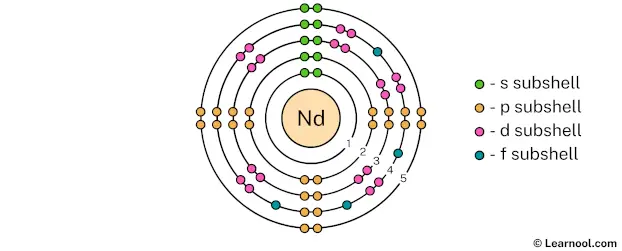
In the above image, 5 represents the 5th electron shell that contains 5s and 5p subshells. And the green and orange color represents the number of electrons in that subshell. This means that the 5th electron shell has a total of 8 electrons.
The 5th electron shell contains only 5s and 5p subshells, and not 5d and 5f subshells. This is because according to the aufbau principle, the 6s subshell is filled first and then 4f, 5d, 6p… and so on.
Now we have already used 58 electrons in 1st, 2nd, 3rd, 4th, and 5th electron shells, so we have 60 – 58 = 2 electrons left. So in the next step, we have to draw the 6th electron shell.
Draw 6th electron shell
The 6th electron shell can hold up to a maximum of 72 electrons. So draw the 6th electron shell as follows:
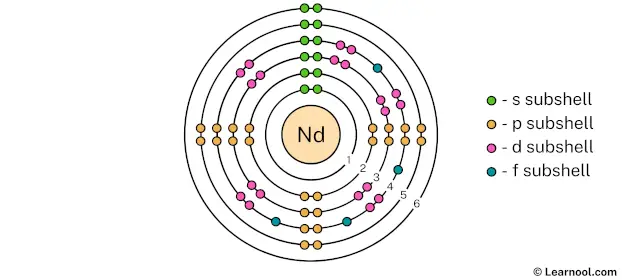
In the above image, 6 represents the 6th electron shell that contains 6s subshell. And the green color represents the number of electrons in that subshell. This means that the 6th electron shell has a total of 2 electrons.
That’s it! This is the final Bohr model of neodymium atom as we have used all 60 electrons: 2 electrons in the 1st electron shell, 8 electrons in the 2nd electron shell, 18 electrons in the 3rd electron shell, 22 electrons in the 4th electron shell, 8 electrons in the 5th electron shell, and 2 electrons in the 6th electron shell.
Next: Promethium Bohr model
Related
More topics
External links
- File:60 neodymium (Nd) enhanced Bohr model copy.png – Wikimedia Commons
- Chemical Elements.com – Neodymium (Nd) – Chemical Elements.com
- What is the Bohr model for Neodymium? – Topblogtenz
- Neodymium (Nd) – Periodic Table – ChemicalAid
Deep
Learnool.com was founded by Deep Rana, who is a mechanical engineer by profession and a blogger by passion. He has a good conceptual knowledge on different educational topics and he provides the same on this website. He loves to learn something new everyday and believes that the best utilization of free time is developing a new skill.
